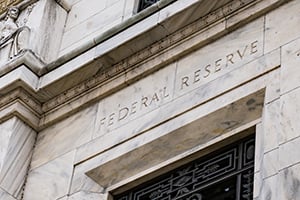 The biggest financial and economic story in recent days has been around interest rates. Inflation worries flared up again with the passage of the most recent federal stimulus bill, on fears that dumping trillions of dollars into the economy would drive demand—and prices—up. Rates followed, with the yield on the 10-year U.S. Treasury note rising from 1.07 percent to a peak of 1.59 percent on March 8. Stock prices, especially for growth stocks, reacted by dropping, as higher rates usually mean lower valuations.
The biggest financial and economic story in recent days has been around interest rates. Inflation worries flared up again with the passage of the most recent federal stimulus bill, on fears that dumping trillions of dollars into the economy would drive demand—and prices—up. Rates followed, with the yield on the 10-year U.S. Treasury note rising from 1.07 percent to a peak of 1.59 percent on March 8. Stock prices, especially for growth stocks, reacted by dropping, as higher rates usually mean lower valuations.
This is the context for the regular meeting of the Fed, which starts today and ends tomorrow. While the Fed could change its policies, no one really expects that. The comments from all members have been quite consistent that current policies are likely to remain unchanged for some time. Still, markets will be watching closely, even if they don’t do anything, to see what the Fed says.
No Reasons to Change Policy?
So, what will the Fed say? Probably nothing of significance. The Fed has historically raised obscurity to an art form. While the Powell Fed has become more forthcoming, that means that anything it does say will be acted on. So, unless the Fed wants markets to react, it has to revert to obscurity—which is what I expect.
Because the truth is, the Fed has been very clear that it plans to keep current policy in place for some time, until the economy shows unmistakable signs of above-trend growth and inflation. Of its two mandates, employment and inflation, the Fed is choosing to focus on employment (which is still well under water) and not on inflation (which is not a problem).
The most recent data confirms that view. Job growth was better last month, but there are still 10 million people out of work. Tuesday’s retail sales report was terrible, illustrating that demand is still relatively weak and not bounding ahead in a way that would drive inflation. And the actual inflation data, especially on the consumer side, is still low. Employment is low, people are not yet spending, and inflation is still under control. Based on what the Fed has said it wants—and what it is supposed to want—there are no reasons to change policy.
Things Could Change
That story could certainly change in coming months. As vaccinations proceed and the economy reopens, the employment picture will keep improving. More jobs and a more open economy should mean more spending and more demand. And producer price inflation, which is higher, could start to drive consumer inflation higher. All of that could happen.
But, as the Fed has seen several times this cycle, because something could happen does not mean that it will. The Fed has been burned before by tightening policy prematurely. As we emerge from the pandemic, such tightening could cause even more damage. And, if you look at recent history, while rates are up, they have just gone back to pre-pandemic levels, which is what you would expect as the economy normalizes. The recent rate increases are likely much more about a normalizing economy than about pending inflation.
Focus on Employment, Not Inflation
Markets, which are after all about capital, tend to focus most on inflation, and that is what we are seeing today. They want the Fed to act to avert even a distant threat of inflation, regardless of the consequences for the real economy. The Fed, historically, has had the same focus. But with inflation at low levels for the past decade now and with unemployment as high as it is, the Fed is now clear that the focus for the moment is on employment, not inflation. One is a problem, and the other isn’t.
Given that, expect the Fed to stand pat for this meeting.


 Print
Print

